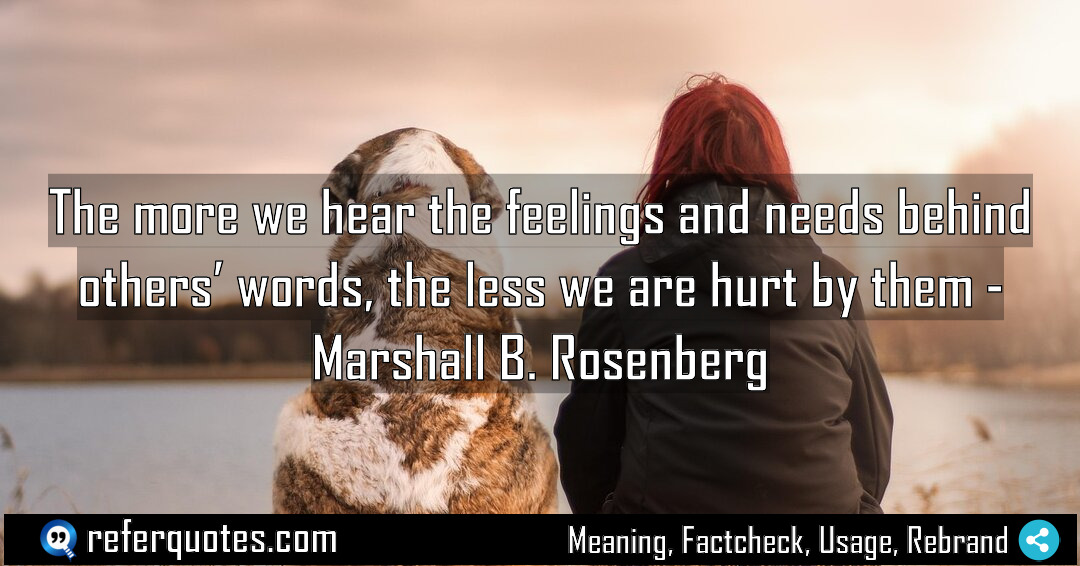
You know, the more we hear the feelings… it completely changes how we handle tough conversations. It’s like putting on armor made of understanding. This shifts the entire dynamic from defense to connection.
Share Image Quote:
Table of Contents
Meaning
At its core, this is about shifting your focus from the surface-level words someone is using to the deeper human emotion and need that’s driving them. It’s the difference between hearing an attack and hearing a cry for help.
Explanation
Let me break this down from my own experience. When someone says something that feels like a personal jab—like “You’re so irresponsible!”—our instinct is to get defensive, right? We feel hurt, and we either shut down or fire back. But Rosenberg’s genius is in teaching us to listen *through* the judgment. To ask ourselves, “What is this person *feeling* right now? And what universal *need* of theirs isn’t being met?”
Maybe their feeling is frustration or fear. Their unmet need could be for reliability or support. The moment you make that shift in your own mind, something magical happens. The sting of the words just… vanishes. You stop seeing a critic and start seeing a struggling human being. It’s not about agreeing with them; it’s about understanding their humanity. And that understanding is what makes you bulletproof to the hurt.
Quote Summary
Reading Level80
Aesthetic Score85
Origin & Factcheck
This quote comes straight from Marshall B. Rosenberg’s seminal book, Nonviolent Communication: A Language of Life. The book was first published in the United States in 1999 and has since become a cornerstone for mediators, therapists, and anyone looking to improve their communication. You sometimes see the core ideas floating around without attribution, but this specific phrasing is pure Rosenberg.
Attribution Summary
Where is this quotation located?
| Quotation | The more we hear the feelings and needs behind others’ words, the less we are hurt by them |
| Book Details | Publication Year: 1999; ISBN: 9781892005038; Last edition: 3rd Edition (2015); Number of pages: 264. |
| Where is it? | Chapter 7: Receiving Empathically, Page 121 (2015 edition) |
Context
In the book, this isn’t just a nice idea; it’s a practical step in the 4-part NVC process. The framework teaches you to observe without evaluating, identify feelings, connect them to universal needs, and then make a request. This quote sits at the heart of that process—it’s the skill that allows you to receive someone else’s message, however poorly delivered, without taking it personally.
Usage Examples
So, how do you actually use this? Let’s get practical.
- In a Heated Argument with a Partner: Instead of reacting to “You never listen to me!”, you listen for the feeling (loneliness, frustration) and the need (to be heard, connection). Your response shifts from “Yes I do!” to “It sounds like you’re feeling really alone and you need to feel heard by me. Is that right?” Game changer.
- With a Frustrated Colleague: A boss says, “This report is a mess.” Defensiveness kicks in. But if you hear the possible feeling (concern) and need (for clarity or quality), you can engage productively: “Are you concerned that it doesn’t meet the project’s need for clarity? Let’s go over the specific sections.”
- For Anyone in a Leadership or Caregiving Role: Teachers, managers, parents—this is your secret weapon. It de-escalates conflict and builds trust almost instantly.
To whom it appeals?
Share This Quote Image & Motivate
Motivation Score85
Popularity Score90
Shareability Score85
Common Questions
Question: Does this mean I just have to take verbal abuse?
Answer: Absolutely not. That’s a huge misconception. Understanding someone’s feelings and needs empowers you to set a *more effective* boundary. You can say, “I hear that you’re angry and you need respect. I need respect, too, so let’s find a way to talk about this without yelling.” You’re addressing the root cause, not the symptom.
Question: This sounds really hard to do in the moment. Is it?
Answer: Oh, it’s incredibly difficult at first. It’s a muscle you have to build. I started by practicing in low-stakes situations, or even just running past conversations through this lens in my head. It gets easier, I promise. The payoff in peace of mind is worth the effort.
Question: What if I get the feeling or need wrong?
Answer: That’s the beauty of it—it’s a guess! The goal is to demonstrate empathetic listening. You just make your best guess: “It sounds like you’re feeling overwhelmed because you need some support, is that it?” If you’re wrong, they’ll correct you, and that conversation in itself moves you closer to understanding.
Similar Quotes
You know, “People who can’t express their feelings are at risk…” is such a powerful truth. It explains so much about workplace blow-ups and personal conflicts we see every day.…
When we stay with empathy, we allow others to fully express themselves. It’s a game-changer because it removes the fear of judgment. This simple shift transforms how we connect with…
Every emotion offers a message and a lesson… it’s a game-changer. It means our feelings aren’t random noise; they’re data. Ignoring them is like deleting a crucial file about yourself.…
Seeing the truth often hurts less… it’s a gut punch of a line, right? But it’s one of those truths that, once you really get it, changes how you approach…
When we listen for feelings and needs, we stop seeing monsters. It’s a game-changer in communication because it reframes every difficult interaction not as a personal attack, but as a…
